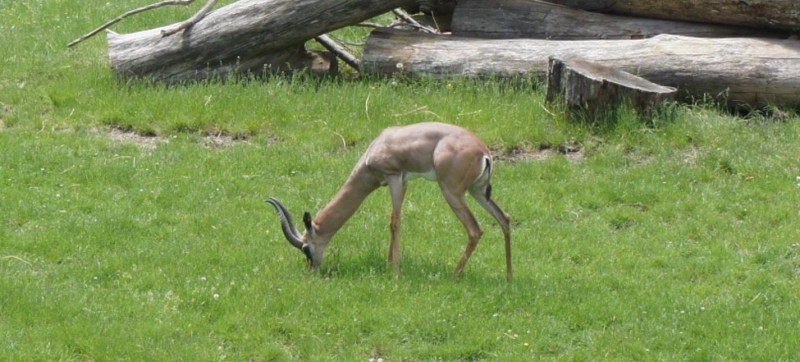Gerenuk - Litocranius walleri


Habitat:
Varies from the treeless plains of Tanzania in the southern reaches of its range to the dry high deserts of Kenya. They are adaptable and do well in a variety of habitats, provided there is a good supply of succulent plants.
Range:
Eastern Africa-Tanzania, Kenya, and southern Somolia.
Features:
The long neck and long, thin legs of gerenuks are their defining features. The coat is of a short, fine, glossy hair that is evenly distributed over the whole body. The pelage is a pale tawny brown with white along the breast, underbelly, and inner legs. There are small, dark patches of fur on the knees of the forelegs and at the end of the tail.
Size:
28-37 inches at the shoulder. 56-64 inches long. 62-115 pounds in weight.
Social Structure:
Gerenuks live in small groups, which may consist of related females and their young, or in bachelor groups of males or as solitary males. The latter are thought to be territorial, but as their ranges are large and populations usually sparse, it has been difficult for scientists to determine if they defend these territories. The female groups wander over a home range of 1 to 2 square miles, passing in and out of male territories.
Life Expectancy:
10-12 years
Diet:
They are well adapted to eating food in arid environments. Their longs legs and neck allow them to eat leaves from trees too tall for other ungulates. They eat a variety of herbaceous plants (over 80 different kinds) and derive water from the succulents they eat rather than drinking standing water.
Reproduction:
Polygynous breeding system. Breed throughout year. Gestation is 6.75 – 7 months; 12 - 18 months to wean (avg 15). Both sexes become sexually mature at 1-2 years. Females usually give birth to one young. Young are precocial.
Status:
Since the gerenuk is a game animal it is protected in most of its range in the form of tags or permits. There are many parks offering sanctuary for them within their range and many biologists and game managers studying them so they are not considered to be at significant risk currently. They are considered of little concern and are part of an AZA Species Survival Plan.
Interesting Facts:
- Gerenuks have a complex mating ritual: When a male encounters a potential mate the female will raise her nose into the air and pull her ears close to the head as a sign of defensiveness, meanwhile the male displays his horns and neck in a sideways pose. If the female is receptive then the male will mark the female on the thigh with the contents of his preorbital gland and continue to follow her around, a form of mate guarding. As the male follows the female he continually uses his forelegs to kick the female in her thigh region. When the female attempts to urinate the male performs the flehmen test or lip curl test in which he samples her urine. Once the female comes into estrous the male will notice the difference in the females’ urine and mating will begin. Males will attempt to mate with as many females as they can.
- Gerenuk contribute to nutrient cycling in the ecosystems in which they live through their foraging activity
- Gerenuks have pre-orbital glands in front of the eyes that emit a tar-like, scent-bearing substance they deposit on twigs and bushes to mark their territory. They also have scent glands on their knees that are covered by tufts of hair and between their split hooves.

AZA cooperatively manages this species as a Species Survival Plan® Program.
Prices
- Adult (13 and over)$12.50
- Child (2 - 12)$9.00
- Child (1 and Under)FREE
- Senior (65+)$11.50
- Active Military$11.50
We begin transferring animals to evening (off exhibit) holding at 4:30 each night.
Find Us
2320 N. Prospect Rd.
Peoria, IL 61603
Phone: 309-686-3365
Open Daily 10:00-5:00
Last admission at 4:30
